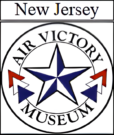
Our E-2B Hawkeye Bu No. 152484
HISTORY OF THIS AIRCRAFT
The history of this aircraft: the E-2 on display was delivered to the US Navy as an E-2A model in September 1966 and later upgraded to the E-2B standard in January 1970 after undergoing a complete computer and radar upgrade. Our aircraft saw service aboard the USS America and later saw service on the USS John F. Kennedy, USS Ranger, USS Midway, USS Forrestal and USS Independence. She was assigned to several early warning squadrons, including VAW-12, VAW-115 VAW-117, VAW-122, VAW-124, VAW-125, VAW-126, RVAW-110 and RVAW-120. On January 14 1986 this aircraft was retired at Lakehurst NJ and transferred to the AVM September 11 1995.
Museum volunteers, with the help of Dennys Towing, towed the 38,000 pound aircraft over the road from Lakehurst NAES to the Air Victory Museum overnight.
Grumman delivered our Hawkeye as a E-2A model in September 1966. It was upgraded to E-2B standard in January 1970 The E-2 was designed as a Airborne Early Warning platform. The E-2B can track upto 300 targets both in the air and on the surface or ground. Hawkeyes have been sold to Israel, Japan, Egypt, Singapore, Taiwan, Thailand and France.
The continuous improvements in early airborne radars by 1956 led to the concept of an airborne early warning and command and control aircraft. The first aircraft to perform this mission was the Grumman E-1 Tracer (a variant of the S-2 Tracker anti-submarine aircraft), which saw service from 1954 to 1964. The E-1’s successor, the E-2 Hawkeye, was the first carrier-based aircraft designed from the outset for the all-weather airborne early warning and command and control function. Since replacing the E-1 in 1964, the Hawkeye has been the “eyes of the fleet.” Since its combat debut during the Vietnam conflict, the E-2 has served the Navy around the world. Hawkeyes directed F-14 Tomcat fighters flying combat air patrol during the two-carrier battle group joint strike against terrorist-related Libyan targets in 1986. E-2Cs and AEGIS cruisers, working together, provided total air mass superiority over the American fleet.
More recently, E-2Cs provided the command and control for successful operations during the Persian Gulf War, directing both land attack and combat air patrol missions over Iraq and providing control for the shoot-down of two Iraqi MIG-21 aircraft by carrier-based F/A-18s in the early days of the war. E-2 aircraft also have worked extremely effectively with U.S. law enforcement agencies in drug interdictions. The newest version of the Hawkeye, the E-2C, became operational in 1973.
The E-2C Hawkeye is the U.S. Navy’s all-weather, carrier-based tactical airborne warning and control system platform. It provides all-weather airborne early warning and command and control functions for the carrier battle group. Additional missions include surface surveillance coordination, strike and interceptor control, search and rescue guidance and communications relay.
An integral component of the carrier air wing, the E-2C carries three primary sensors: radar, IFF, and a passive detection system. These sensors are integrated through a general purpose computer that enables the E-2C to provide early warning, threat analyses, and control of counter action against air and surface targets. The E-2C incorporates the latest solid state electronics.
The fuselage is designed for carrier operations and is fitted with a nose-tow catapult attachment for accelerated carrier take-off, an A-frame arrester hook for engagement of the arresting gear and a tail bumper to withstand impact or scraping on the runway. For storage in the hangar, the wings fold hydraulically to lie flat to the fuselage. The fuselage is of light metal construction, and parts of the tailplane are of composite structure in order to reduce radar signature.
